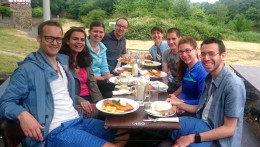Reducing CO2 emissions is a major challenge on our way to curbing climate change. DAAD scholars from Munich, Erlangen-Nuremberg, Straubing, Bayreuth, and Eichstätt visited a pilot plant which produces green hydrogen, using a process which has the potential to save huge amounts of emissions.
Hydrogen is expected to play a crucial role in the energy transition, for example in industry and mobility. But production is energy-intensive and transportation difficult. Munich DAAD alumnus Dr. Gianluca Pauletto has developed an innovative process to produce green hydrogen decentrally and very efficiently from biogas. During our visit in June 2024 he and a colleague showed us around the plant run by his startup-company Sypox and answered our numerous questions.
Sypox, which Gianluca founded with support from TUM, devotes itself to electrifying processes in the chemical industry https://sypox.eu/. As yet the process employed in the Dollnstein plant is still in the pilot stage. We were able to see all steps of the process, starting with the delivery of the raw material, which is mostly cut grass.
The plant is located a little outside of the picturesque village of Dollnstein in the lovely Altmühl Valley, a recreational area west of Ingolstadt which is popular for climbing and canooing (which we have already done a few years ago). Its emissions in terms of noise and smell are low, therefore it was easy to get permission to run the pilot.
Partners in this endeavour are a local organic farmer who was looking for a new use for the biogas that he is producing, and the company Bayerngas. Here like in thousands of biogas plants in Germany, biogas was mostly used to produce electricity. Government subsidies for this business are limited in time, and the process is not very efficiient. Therefore using biogas to produce hydrogen in a very energy efficient way is a viable and attractive alternative.
Several of the participants were chemical engineers and/or interested in the prospect of decentral energy production. We were all eager to also explore the lovely area. We had worked out two options how to spend the rest of the day after the visit to the plant: To go on a hike near Dollnstein, for example walk the Altmühltal Panorama Hike, or to proceed to the nearby charming university town of Eichstätt and visit the Jura Museum with its numerous fascinating fossils, including a rare specimen of the archeopteryx.
Unfortunately the day of our visit was unpleasantly hot (thus demonstrating the dire effects of climate change) and there was little shade at the plant. Therefore walking back to Dollnstein and resting in a shady beergarden there was the most we could manage. It gave the participants from the different regional groups the opportunity to get to know each other better. Not the first time on a joint outing of the regional groups Munich and Erlangen-Nuremberg, friends unexpectedly met that day, an additional bonus.
It gave the participants from the different regional groups the opportunity to get to know each other better. Not the first time on a joint outing of the regional groups Munich and Erlangen-Nuremberg, friends unexpectedly met that day, an additional bonus.
This was the second time in 2024 that the RG Munich went on a trip together with another RG. Outings in conjunction with the RG Erlangen-Nuremberg already have a longer history which will be continued.
Soon after our visit to the Sypox plant we continued exploring the theme of startups and the role TUM plays in supporting them. We visited the TUM Venture Lab Food Agriculture Biotech/FAB in Weihenstephan. Once again contact was established by a DAAD alumnus, in this case DAAD-Freundeskreis member Dr. Klaus-Jürgen Werner, whose son Roman is managing director of this Venture Lab.
Sibylle Wahl, Regional Group Munich
Additional information
Categories
- General (17)
- Germany Behind the Scenes (8)
- Reports (52)
Keywords
- Berlin (22)
- Bonn (7)
- Bonn Dr. Christian Bode (1)
- Braunschweig-Hannover (1)
- Cologne (1)
- Dresden (4)
- Düsseldorf (2)
- Freiburg (2)
- Hamburg (2)
- Heidelberg (1)
- Karlsruhe (1)
- Marburg (1)
- Munich (8)
- Rhine-Main (3)
- Rhine-Neckar (2)
- Saarland (1)
- Stuttgart (1)
- Trier (1)
- Tübingen (3)

